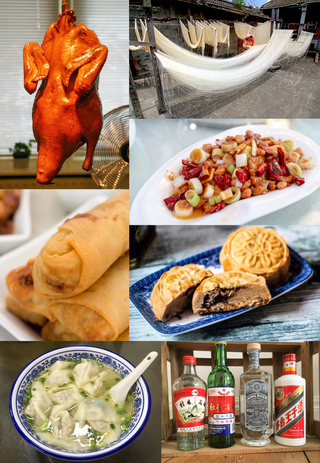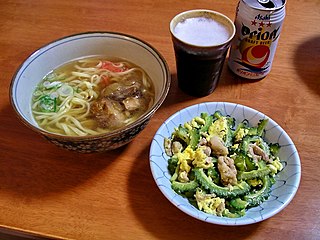
Chinese cuisine comprises cuisines originating from China, as well as from Chinese people from other parts of the world. Because of the Chinese diaspora and historical power of the country, Chinese cuisine has profoundly influenced many other cuisines in Asia and beyond, with modifications made to cater to local palates. Chinese food staples such as rice, soy sauce, noodles, tea, chili oil, and tofu, and utensils such as chopsticks and the wok, can now be found worldwide.

Japanese cuisine encompasses the regional and traditional foods of Japan, which have developed through centuries of political, economic, and social changes. The traditional cuisine of Japan is based on rice with miso soup and other dishes with an emphasis on seasonal ingredients. Side dishes often consist of fish, pickled vegetables, and vegetables cooked in broth. Common seafood is often grilled, but it is also sometimes served raw as sashimi or as sushi. Seafood and vegetables are also deep-fried in a light batter, as tempura. Apart from rice, a staple includes noodles, such as soba and udon. Japan also has many simmered dishes, such as fish products in broth called oden, or beef in sukiyaki and nikujaga.

Korean cuisine has evolved through centuries of social and political change. Originating from ancient agricultural and nomadic traditions in Korea and southern Manchuria, Korean cuisine reflects a complex interaction of the natural environment and different cultural trends.
Taiwanese cuisine is a popular style of food with several variations, including Chinese and that of Taiwanese indigenous peoples, with the earliest cuisines known of being the indigenous ones. With over a hundred years of historical development, mainstream Taiwanese cuisine has been influenced by Hakka cuisine, the cuisines of the waishengren, Japanese cuisine, and American cuisine, with southern Fujian cuisine having had the most profound impact.

Indonesian cuisine is a collection of various regional culinary traditions that formed in the archipelagic nation of Indonesia. There are a wide variety of recipes and cuisines in part because Indonesia is composed of approximately 6,000 populated islands of the total 17,508 in the world's largest archipelago, with more than 1,300 ethnic groups.

Bengali cuisine is the culinary style of Bengal, that comprises Bangladesh and the Indian states of West Bengal and Tripura. The cuisine has been shaped by the region's diverse history and climate. It is known for its varied use of flavours including mustard oil, as well as the spread of its confectioneries and desserts. There is a strong emphasis on rice as a staple, with fish traditionally the most common protein. Freshwater fish are preferred to seafish, although barramundi, known as bhetki, is also common. Meat is also a common protein among Bengalis with chicken and mutton meat being the most popular. Beef is popular within the muslim community. In more recent times, lentils have begun to form a significant part of the diet. Many Bengali food traditions draw from social activities, such as adda, Mezban, Eid feast.

Latin American cuisine is the typical foods, beverages, and cooking styles common to many of the countries and cultures in Latin America. Latin America is a highly racially, ethnically, and geographically diverse with varying cuisines. Some items typical of Latin American cuisine include maize-based dishes arepas, empanadas, pupusas, tacos, tamales, tortillas and various salsas and other condiments. Sofrito, a culinary term that originally referred to a specific combination of sautéed or braised aromatics, exists in Latin American cuisine. It refers to a sauce of tomatoes, roasted bell peppers, garlic, onions and herbs. Rice, corn, pasta, bread, plantain, potato, yucca, and beans are also staples in Latin American cuisine.
European cuisine comprises the cuisines that originate from the various countries of Europe.

Jewish cuisine refers to the worldwide cooking traditions of the Jewish people. During its evolution over the course of many centuries, it has been shaped by Jewish dietary laws (kashrut), Jewish festivals and holidays, and traditions centred around Shabbat. Jewish cuisine is influenced by the economics, agriculture, and culinary traditions of the many countries where Jewish communities have settled and varies widely throughout the entire world.

Korean royal court cuisine was the style of cookery within Korean cuisine traditionally consumed at the court of the Joseon Dynasty, which ruled Korea from 1392 to 1910. There has been a revival of this cookery style in the 21st century. It is said that twelve dishes should be served along with rice and soup, with most dishes served in bangjja (bronzeware).

Burmese cuisine encompasses the diverse regional culinary traditions of Myanmar, which have developed through longstanding agricultural practices, centuries of sociopolitical and economic change, and cross-cultural contact and trade with neighboring countries at the confluence of South Asia, Southeast Asia, and East Asia, including the modern-day nations of India, China, and Thailand. Mohinga, a savory fish soup with lemongrass and banana leaves are eaten for breakfast with rice noodles, lunch is rice accompanied with small side dishes of vegetables, a small soup and a meat or fish dish. Dinner is consumed in a similar fashion to lunch. Burmese stews or curries are not Indian curries but milder with reliance on the trio of onion garlic and ginger to create savory gravies. Burmese food does not rely heavily on coconut such as in Thai cuisine. Burmese however enjoy spicy food with addition of chilis mixed into the dishes.

Noodle soup refers to a variety of soups with noodles and other ingredients served in a light broth. Noodle soup is a common dish across East Asia, Southeast Asia and the Himalayan states of South Asia. Various types of noodles are used, such as rice noodles, wheat noodles and egg noodles.

Okinawan cuisine is the cuisine of the Okinawa Prefecture of Japan. The cuisine is also known as Ryūkyūan cuisine, a reference to the Ryukyu Kingdom. Due to differences in culture, historical contact between other regions, climate, vegetables and other ingredients, Okinawan cuisine differs from mainland Japanese cuisine.

Padang dish or Minangkabau dish is the cuisine of the Minangkabau people of West Sumatra, Indonesia. It is among the most popular cuisines in Maritime Southeast Asia. It is known across Indonesia as Masakan Padang after Padang, the capital city of Western Sumatra province. It is served in restaurants mostly owned by perantauan (migrating) Minangkabau people in Indonesian cities. Padang food is ubiquitous in Indonesian cities and is popular in neighboring Malaysia and Singapore.

Chadian cuisine is the cooking traditions, practices, foods and dishes associated with the Republic of Chad. Chadians use a medium variety of grains, vegetables, fruits and meats. Commonly consumed grains include millet, sorghum, and rice as staple foods. Commonly eaten vegetables include okra and cassava. A variety of fruits are also eaten. Meats include mutton, chicken, pork, goat, fish, lamb and beef. The day's main meal is typically consumed in the evening on a large communal plate, with men and women usually eating in separate areas. This meal is typically served on the ground upon a mat, with people sitting and eating around it.

The cuisine of Mauritius is greatly influenced by the tropical location of the island as well as the cultural diversity which characterizes the country. Mauritian cuisine is a blend of African, Chinese, European and Indian influences in the history of Mauritius. Most of the dishes and culinary traditions are inspired by French culture, former African slaves, Indian workers and Chinese migrants that arrived in the country during the 19th century. Over the years, communities found in Mauritius have adapted and mixed each other's cuisine to their liking, resulting in the development of Mauritian cuisine. While some popular dishes and desserts are consumed by Mauritians of all ethnic groups or communities, there are also forms of cuisines which remain distinctly ethnic and are unique to a specific ethnic community due to their ancestral cultural and historical connections. Local food which varies depending on ethnic communities therefore reflects the strong traditional, cultural, and historical influences of each community. French cuisine is very popular in Mauritius. Sino-Mauritian cuisine is one of the most prevalent in the restaurants throughout the island.

Nasi padang, sometimes referred to as Padang rice, is a Minangkabau dish of steamed rice served with various choices of pre-cooked dishes originating from West Sumatra, Indonesia. It is named after the city of Padang, capital of the West Sumatra province. A miniature banquet of meats, fish, vegetables, and spicy sambals eaten with plain white rice, it is Sumatra's most famous export and the Minangkabau people's primary contribution to Indonesian cuisine.

Hot pot or hotpot, also known as steamboat, is a dish whereby a heat source placed on the dining table keeps a pot of soup stock simmering, and a variety of Chinese foodstuffs and ingredients are served beside the pot for the diners to put into the hot stock.

Kaiseki (懐石) or kaiseki-ryōri is a traditional multi-course Japanese dinner. The term also refers to the collection of skills and techniques that allow the preparation of such meals and is analogous to Western haute cuisine.



















